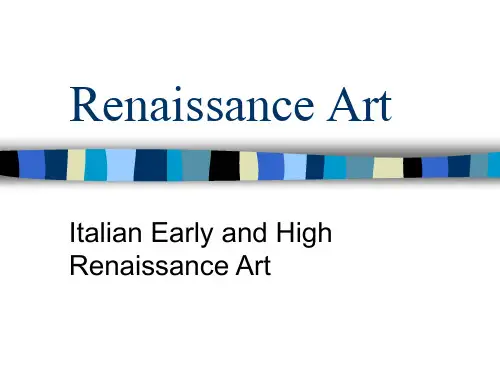意大利文艺复兴艺术 英文
- 格式:ppt
- 大小:4.98 MB
- 文档页数:4
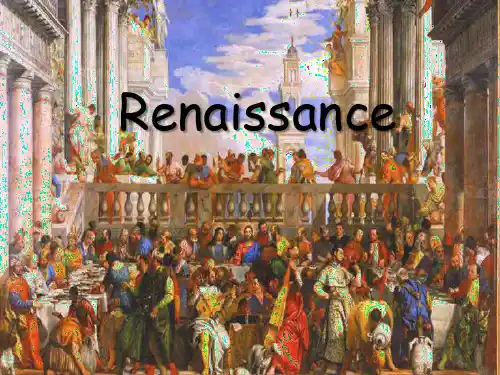
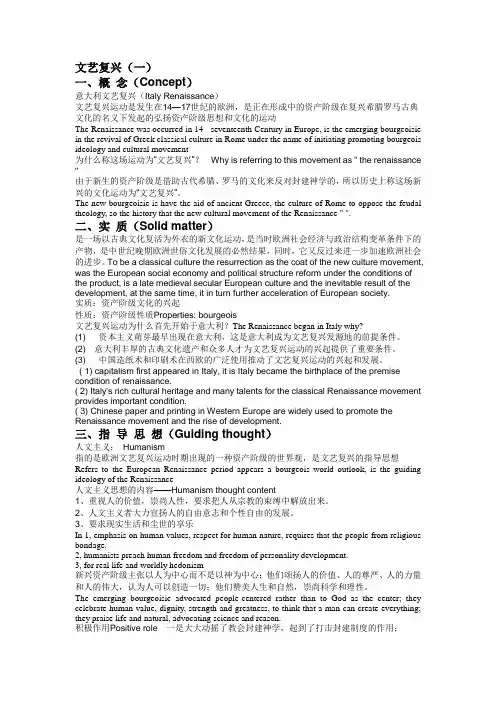
文艺复兴(一)一、概念(Concept)意大利文艺复兴(Italy Renaissance)文艺复兴运动是发生在14—17世纪的欧洲,是正在形成中的资产阶级在复兴希腊罗马古典文化的名义下发起的弘扬资产阶级思想和文化的运动The Renaissance was occurred in 14 - seventeenth Century in Europe, is the emerging bourgeoisie in the revival of Greek classical culture in Rome under the name of initiating promoting bourgeois ideology and cultural movement为什么称这场运动为“文艺复兴”?Why is referring to this movement as " the renaissance "由于新生的资产阶级是借助古代希腊、罗马的文化来反对封建神学的,所以历史上称这场新兴的文化运动为“文艺复兴”。
The new bourgeoisie is have the aid of ancient Greece, the culture of Rome to oppose the feudal theology, so the history that the new cultural movement of the Renaissance " ".二、实质(Solid matter)是一场以古典文化复活为外衣的新文化运动,是当时欧洲社会经济与政治结构变革条件下的产物,是中世纪晚期欧洲世俗文化发展的必然结果,同时,它又反过来进一步加速欧洲社会的进步。
To be a classical culture the resurrection as the coat of the new culture movement, was the European social economy and political structure reform under the conditions of the product, is a late medieval secular European culture and the inevitable result of the development, at the same time, it in turn further acceleration of European society.实质:资产阶级文化的兴起性质:资产阶级性质Properties: bourgeois文艺复兴运动为什么首先开始于意大利?The Renaissance began in Italy why?(1) 资本主义萌芽最早出现在意大利,这是意大利成为文艺复兴发源地的前提条件。
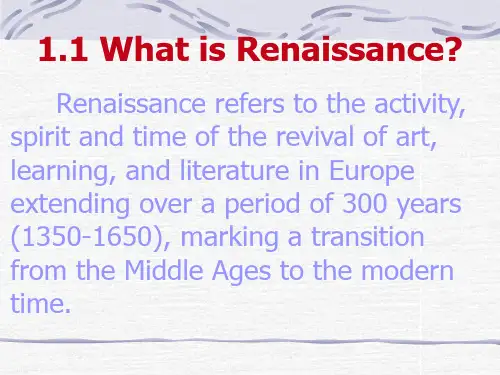
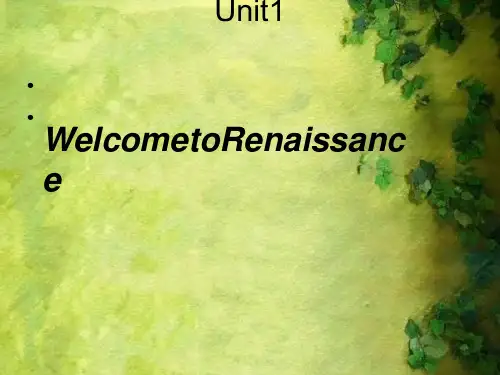
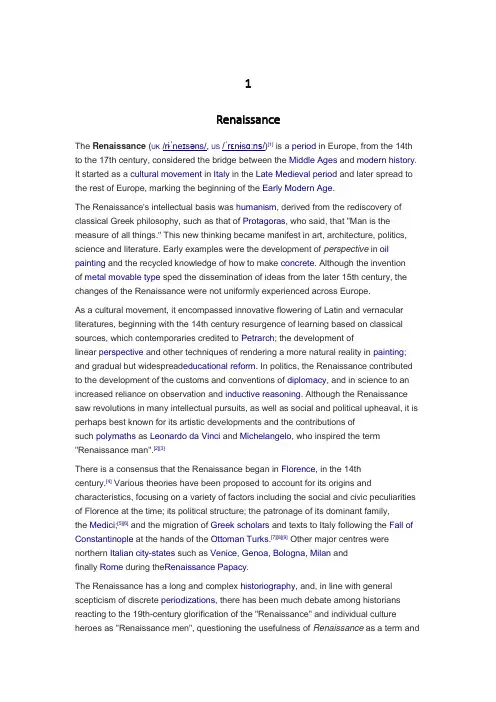
1RenaissanceThe Renaissance (UK/rɨˈneɪsəns/, US/ˈrɛnɨsɑːns/)[1] is a period in Europe, from the 14th to the 17th century, considered the bridge between the Middle Ages and modern history. It started as a cultural movement in Italy in the Late Medieval period and later spread to the rest of Europe, marking the beginning of the Early Modern Age.The Renaissance's intellectual basis was humanism, derived from the rediscovery of classical Greek philosophy, such as that of Protagoras, who said, that "Man is the measure of all things." This new thinking became manifest in art, architecture, politics, science and literature. Early examples were the development of perspective in oil painting and the recycled knowledge of how to make concrete. Although the inventionof metal movable type sped the dissemination of ideas from the later 15th century, the changes of the Renaissance were not uniformly experienced across Europe.As a cultural movement, it encompassed innovative flowering of Latin and vernacular literatures, beginning with the 14th century resurgence of learning based on classical sources, which contemporaries credited to Petrarch; the development oflinear perspective and other techniques of rendering a more natural reality in painting; and gradual but widespread educational reform. In politics, the Renaissance contributed to the development of the customs and conventions of diplomacy, and in science to an increased reliance on observation and inductive reasoning. Although the Renaissance saw revolutions in many intellectual pursuits, as well as social and political upheaval, it is perhaps best known for its artistic developments and the contributions ofsuch polymaths as Leonardo da Vinci and Michelangelo, who inspired the term "Renaissance man".[2][3]There is a consensus that the Renaissance began in Florence, in the 14thcentury.[4] Various theories have been proposed to account for its origins and characteristics, focusing on a variety of factors including the social and civic peculiarities of Florence at the time; its political structure; the patronage of its dominant family,the Medici;[5][6] and the migration of Greek scholars and texts to Italy following the Fall of Constantinople at the hands of the Ottoman Turks.[7][8][9] Other major centres were northern Italian city-states such as Venice, Genoa, Bologna, Milan andfinally Rome during the Renaissance Papacy.The Renaissance has a long and complex historiography, and, in line with general scepticism of discrete periodizations, there has been much debate among historians reacting to the 19th-century glorification of the "Renaissance" and individual culture heroes as "Renaissance men", questioning the usefulness of Renaissance as a term andas a historical delineation.[10] The art historian Erwin Panofsky observed of this resistance to the concept of "Renaissance":It is perhaps no accident that the factuality of the Italian Renaissance has been most vigorously questioned by those who are not obliged to take a professional interest in the aesthetic aspects of civilization—historians of economic and social developments, political and religious situations, and, most particularly, natural science—but only exceptionally by students of literature and hardly ever by historians of Art.[11]Some observers have called into question whether the Renaissance was a cultural "advance" from the Middle Ages, instead seeing it as a period of pessimismand nostalgia for classical antiquity,[12] while social and economic historians, especially of the longue durée, have instead focused on the continuity between the two eras[13] which are linked, as Panofsky himself observed, "by a thousand ties".[14]The word Renaissance, literally meaning "Rebirth" in French, first appears in English in the 1830s.[15] The word occurs in Jules Michelet's 1855 work, Histoire de France. The word Renaissance has also been extended to other historical and cultural movements, such as the Carolingian Renaissance and the Renaissance of the 12th century.[16]2RepresentativesAlfred Tennyson, among many others. In addition, the first use of the interlockingthree-line rhyme scheme, or the terza rima, is attributed to him.Dante has been called "the Father of the Italian language".[2] In Italy, Dante is often referred to as il Sommo Poeta("the Supreme Poet") and il Poeta; he, Petrarch, and Boccaccio are also called "the three fountains" or "the three crowns".The Divine Comedy describes Dante's journeythrough Hell (Inferno), Purgatory (Purgatorio), and Paradise (Paradiso)Dante, like most Florentines of his day, was embroiled in the Guelph–Ghibelline conflict. He fought in the Battle of Campaldino (June 11, 1289), with the Florentine Guelphs against Arezzo Ghibellines; then in 1294 he was among the escorts of Charles Martel of Anjou (grandson of Charles I of Naples, more commonly called Charles of Anjou) while he was in Florence. To further his political career, he became a pharmacist. He did not intend to practice as one, but a law issued in 1295 required nobles aspiring to public office to be enrolled in one of the CorporazionidelleArti e deiMestieri, so Dante obtained admission to the Apothecaries' Guild. This profession was not inappropriate, since at that time books were sold from apothecaries' shops. As a politician he accomplished little, but held various offices over some years in a city rife with political unrest.After defeating the Ghibellines, the Guelphs divided into two factions: the White Guelphs (Guelfi Bianchi)—Dante's party, led by VierideiCerchi—and the Black Guelphs (GuelfiNeri), led by Corso Donati. Although the split was along family lines at first, ideological differences arose based on opposing views of the papal role in Florentine affairs, with the Blacks supporting the Pope and the Whites wanting more freedom from Rome. The Whites took power first and expelled the Blacks. In response, Pope Boniface VIII planned a military occupation of Florence. In 1301, Charles of Valois, brother ofKing Philip IV of France, was expected to visit Florence because the Pope had appointed him peacemaker for Tuscany. But the city's government had treated the Pope's ambassadors badly a few weeks before, seeking independence from papal influence. It was believed that Charles had received other unofficial instructions, so the council sent a delegation to Rome to ascertain the Pope's intentions. Dante was one of the delegates.2. Leonardo da Vinci。
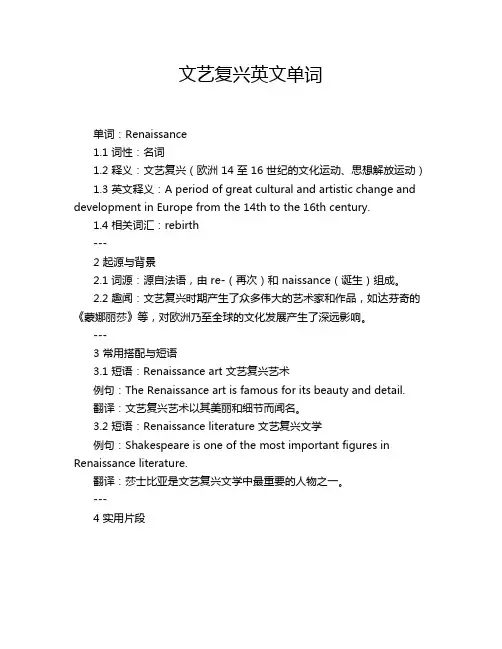
文艺复兴英文单词单词:Renaissance1.1 词性:名词1.2 释义:文艺复兴(欧洲 14 至 16 世纪的文化运动、思想解放运动)1.3 英文释义:A period of great cultural and artistic change and development in Europe from the 14th to the 16th century.1.4 相关词汇:rebirth---2 起源与背景2.1 词源:源自法语,由 re-(再次)和 naissance(诞生)组成。
2.2 趣闻:文艺复兴时期产生了众多伟大的艺术家和作品,如达芬奇的《蒙娜丽莎》等,对欧洲乃至全球的文化发展产生了深远影响。
---3 常用搭配与短语3.1 短语:Renaissance art 文艺复兴艺术例句:The Renaissance art is famous for its beauty and detail.翻译:文艺复兴艺术以其美丽和细节而闻名。
3.2 短语:Renaissance literature 文艺复兴文学例句:Shakespeare is one of the most important figures in Renaissance literature.翻译:莎士比亚是文艺复兴文学中最重要的人物之一。
---4 实用片段(1) "I'm studying the Renaissance period in history class. It's so fascinating to learn about the great thinkers and artists of that time." said Tom. "Yes, the Renaissance was a time of great innovation and creativity." replied the teacher.翻译:“我在历史课上学习文艺复兴时期。
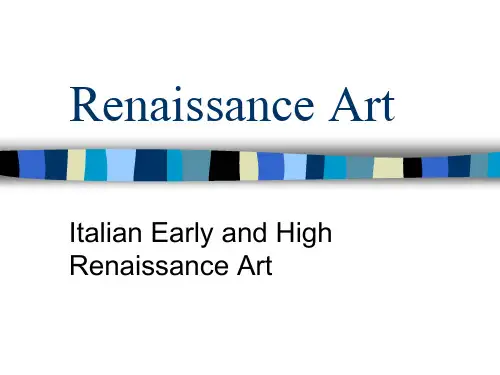

文艺复兴英文介绍The Renaissance, also known as the rebirth, refers to a period in European history between the 14th and 17th centuries. It was characterized by a renewed interest in art, literature, philosophy, and science, marking a transition from the medieval period to the early modern era.During this time, there was a revival of classical learning and a shift towards humanism, emphasizing the importance of individualism, reason, and the potential of human beings. Artists and scholars looked back to the works of ancient Greece and Rome for inspiration and sought to surpass achievements of the past.In the field of art, the Renaissance saw the rise of renowned artists such as Leonardo da Vinci, Michelangelo, and Raphael. These artists explored new techniques and subjects, using perspective and light to create realistic and emotionally powerful works. The concept of beauty shifted from the divine to the idealized human form.In literature, humanism influenced the works of writers like Dante Alighieri, William Shakespeare, and Miguel de Cervantes. Literature became more focused on the individual human experience, exploring themes such as love, morality, and the pursuit of knowledge. The printing press, invented during this period, allowed for widespread dissemination of literature, contributing to an increased interest in reading.Moreover, the Renaissance brought significant advancements in science and technology. Scientists like Nicolaus Copernicus,Galileo Galilei, and Johannes Kepler challenged the traditional understanding of the universe, making groundbreaking discoveries in astronomy, physics, and mathematics. This scientific revolution paved the way for modern scientific methods and thinking.In conclusion, the Renaissance was a transformative period in European history, characterized by a resurgence of interest in art, literature, philosophy, and science. Its humanistic ideals and emphasis on individuality continue to influence Western culture to this day.。
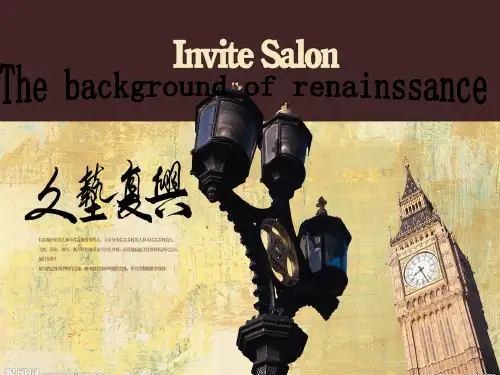
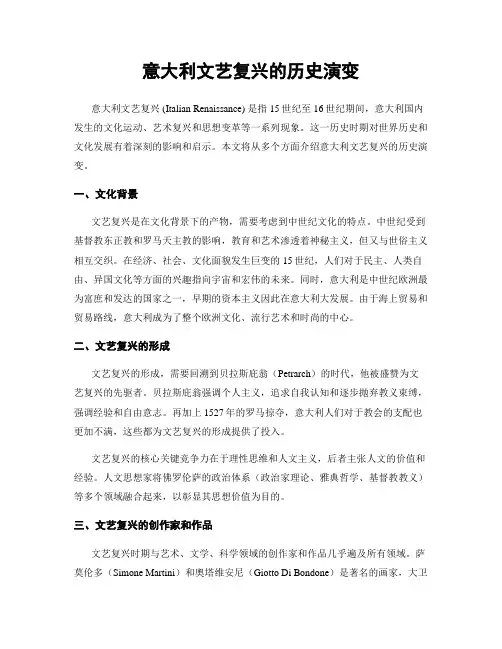
意大利文艺复兴的历史演变意大利文艺复兴 (Italian Renaissance) 是指15世纪至16世纪期间,意大利国内发生的文化运动、艺术复兴和思想变革等一系列现象。
这一历史时期对世界历史和文化发展有着深刻的影响和启示。
本文将从多个方面介绍意大利文艺复兴的历史演变。
一、文化背景文艺复兴是在文化背景下的产物,需要考虑到中世纪文化的特点。
中世纪受到基督教东正教和罗马天主教的影响,教育和艺术渗透着神秘主义,但又与世俗主义相互交织。
在经济、社会、文化面貌发生巨变的15世纪,人们对于民主、人类自由、异国文化等方面的兴趣指向宇宙和宏伟的未来。
同时,意大利是中世纪欧洲最为富庶和发达的国家之一,早期的资本主义因此在意大利大发展。
由于海上贸易和贸易路线,意大利成为了整个欧洲文化、流行艺术和时尚的中心。
二、文艺复兴的形成文艺复兴的形成,需要回溯到贝拉斯庇翁(Petrarch)的时代,他被盛赞为文艺复兴的先驱者。
贝拉斯庇翁强调个人主义,追求自我认知和逐步抛弃教义束缚,强调经验和自由意志。
再加上1527年的罗马掠夺,意大利人们对于教会的支配也更加不满,这些都为文艺复兴的形成提供了投入。
文艺复兴的核心关键竞争力在于理性思维和人文主义,后者主张人文的价值和经验。
人文思想家将佛罗伦萨的政治体系(政治家理论、雅典哲学、基督教教义)等多个领域融合起来,以彰显其思想价值为目的。
三、文艺复兴的创作家和作品文艺复兴时期与艺术、文学、科学领域的创作家和作品几乎遍及所有领域。
萨莫伦多(Simone Martini)和奧塔维安尼(Giotto Di Bondone)是著名的画家,大卫(David)、救世主(Salvator Mundi)和斯芬克斯(Sphinx)等雕塑作品也备受瞩目。
薄伽丘(Giovanni Boccaccio)和但丁(Dante Alighieri)分别是意大利的知名作家,他们的名著《十日谈》和《神曲》影响了整个欧洲文化。
